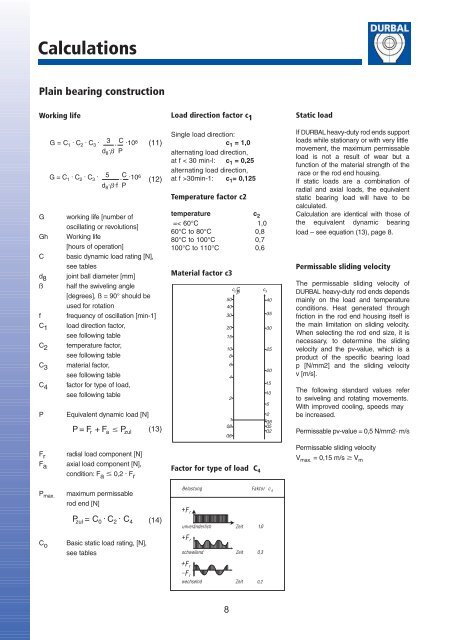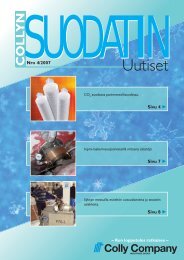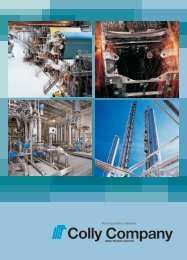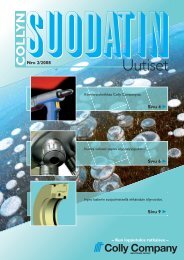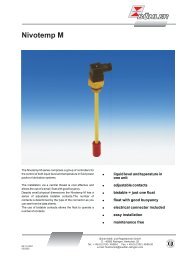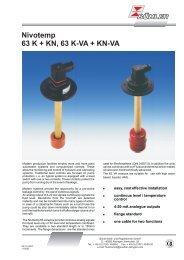You also want an ePaper? Increase the reach of your titles
YUMPU automatically turns print PDFs into web optimized ePapers that Google loves.
Calculations<br />
Plain bearing construction<br />
Working life<br />
(11)<br />
(12)<br />
G working life [number of<br />
oscillating or revolutions]<br />
Gh Working life<br />
[hours of operation]<br />
C basic dynamic load rating [N],<br />
see tables<br />
d8 joint ball diameter [mm]<br />
ß half the swiveling angle<br />
[degrees], ß = 90° should be<br />
used for rotation<br />
f frequency of oscillation [min-1]<br />
C1 load direction factor,<br />
see following table<br />
C2 temperature factor,<br />
see following table<br />
C3 material factor,<br />
see following table<br />
C4 factor for type of load,<br />
see following table<br />
P Equivalent dynamic load [N]<br />
Fr Fa P max.<br />
C o<br />
G = C .<br />
1 C2 . C3 . 3 . C . 108 d .<br />
8 � P<br />
G = C .<br />
1 C2 . C3 . 5 . C . 106 d .<br />
8 � . f P<br />
P=F r +F a � P zul<br />
radial load component [N]<br />
axial load component [N],<br />
condition: Fa � 0,2 . Fr maximum permissable<br />
rod end [N]<br />
P zul = C 0 . C2 . C4<br />
Basic static load rating, [N],<br />
see tables<br />
(13)<br />
(14)<br />
Load direction factor c 1<br />
Single load direction:<br />
c 1 = 1,0<br />
alternating load direction,<br />
at f < 30 min-l: c 1 = 0,25<br />
alternating load direction,<br />
at f >30min-1: c 1 = 0,125<br />
Temperature factor c2<br />
temperature c 2<br />
=< 60°C 1,0<br />
60°C to 80°C 0,8<br />
80°C to 100°C 0,7<br />
100°C to 110°C 0,6<br />
Material factor c3<br />
Factor for type of load C 4<br />
Belastung 4<br />
r<br />
unveränderlich<br />
r<br />
schwellend<br />
r<br />
r<br />
wechselnd<br />
8<br />
0,2<br />
3<br />
Static load<br />
If DURBAL heavy-duty rod ends support<br />
loads while stationary or with very little<br />
movement, the maximum permissable<br />
load is not a result of wear but a<br />
function of the material strength of the<br />
race or the rod end housing.<br />
If static loads are a combination of<br />
radial and axial loads, the equivalent<br />
static bearing load will have to be<br />
calculated.<br />
Calculation are identical with those of<br />
the equivalent dynamic bearing<br />
load – see equation (13), page 8.<br />
Permissable sliding velocity<br />
The permissable sliding velocity of<br />
DURBAL heavy-duty rod ends depends<br />
mainly on the load and temperature<br />
conditions. Heat generated through<br />
friction in the rod end housing itself is<br />
the main limitation on sliding velocity.<br />
When selecting the rod end size, it is<br />
necessary, to determine the sliding<br />
velocity and the pv-value, which is a<br />
product of the specific bearing load<br />
p [N/mm2] and the sliding velocity<br />
v [m/s].<br />
The following standard values refer<br />
to swiveling and rotating movements.<br />
With improved cooling, speeds may<br />
be increased.<br />
Permissable pv-value = 0,5 N/mm2· m/s<br />
Permissable sliding velocity<br />
Vmax. = 0,15 m/s � Vm


